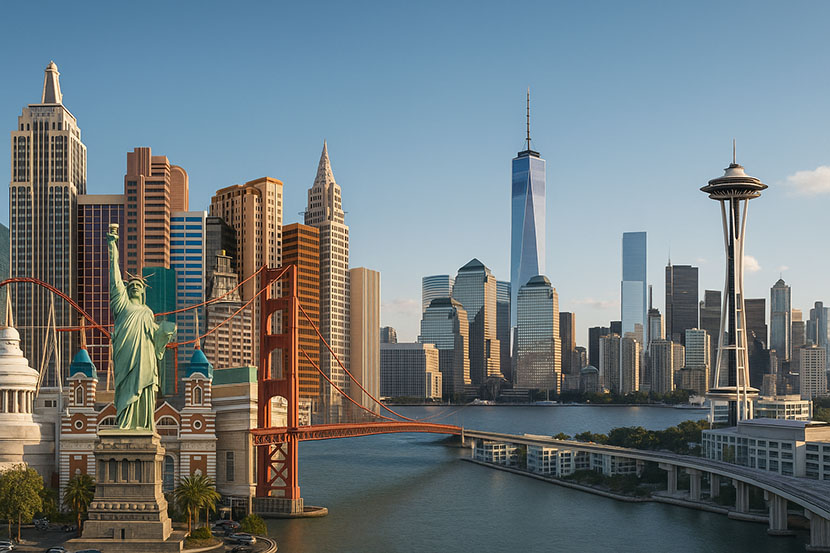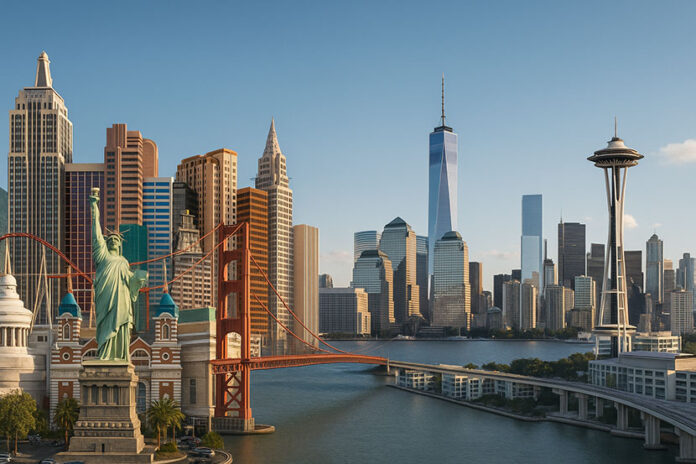Las Vegas Joins Major US Cities in Tourism Slump: An In-Depth Look
Published on August 13, 2025
By: Tuhin Sarkar

Las Vegas has emerged as a new player in the troubling trend of declining tourism that has ensnared some of America’s most iconic cities, including New York, San Francisco, Los Angeles, Miami, and Seattle. These once-thriving hubs of travel and entertainment are now witnessing a downturn, and industry specialists are warning that the effects could ripple throughout the national economy. With falling visitor numbers and reduced spending, this situation demands a closer look at the contributing factors.
Factors Behind the Decline
A primary factor contributing to this tourism slump is the impact of tariffs introduced under former President Donald Trump’s administration, along with Canada’s wavering relationship with the U.S. While these tariffs aim to protect American industries, they have inadvertently led to increased travel costs for international tourists. Higher prices for airfare, goods, and services deter many foreign travelers, particularly from countries that are directly affected by these tariffs.
In cities like Las Vegas, where the economy heavily leans on leisure travel, conventions, and entertainment, the reduction in international visitors carries substantial implications. The situation echoes across various tourist-centered economies, with similar challenges present in New York’s hotel districts, Miami’s cruise terminals, and Seattle’s waterfront attractions. Even the globally recognized cities of San Francisco and Los Angeles are experiencing reduced demand from key foreign markets.
An Overview of Current US Tourism Trends
As we progress through 2025, tourism in the United States faces a significant challenge. Several iconic cities are grappling with a decrease in foreign visitors accompanied by decreased spending. Local politicians and tourism boards have pointed to only one culprit: the combined effects of tariffs, stricter border regulations, and rising costs associated with traveling to the U.S. As a result, burdensome travel conditions are leading many prospective tourists to reconsider their plans.
The Las Vegas Experience: A Tourism Benchmark
Weak Early Summer in Las Vegas
Las Vegas has always been sensitive to shifts in international demand. The recent declines in visitor numbers are especially critical, as international tourists tend to stay longer and spend more generously on dining and entertainment. After a sluggish June and inconsistent July, it’s evident that 2025 is shaping up to be slower than anticipated. Sources indicate that national issues such as trade tensions and stringent entry regulations are discouraging foreign trips to this iconic city.
Changes in the US Travel Landscape
2025 has seen a rise in trade barriers, often referred to as "Trump tariffs." These measures have broad implications, increasing prices across the supply chain, and in turn, elevating costs for travelers. The strengthening U.S. dollar further exacerbates the situation, making holidaying in America feel less economical for many foreign visitors. Additionally, new border checks and visa fees have complicated the entry process, prompting many to opt for alternate destinations.
The Tariff Effect on International Tourism
Interestingly, while tariffs do not target tourists directly, their influence on travel is considerable. They have been known to raise operational costs for airlines, hotels, and retailers, translating to higher prices for travelers. Furthermore, a strong dollar reduces the purchasing power of foreign currencies, making vacations in the U.S. seem pricier. This political and economic climate often discourages leisurely trips and leads many potential travelers to reconsider their options.
Observing National Trends: A Wider Perspective
The broader national context indicates challenges on the horizon for international travel to the U.S. Tracking agencies and booking systems have reported slowed growth in long-haul demand. There’s also been a significant drop in overseas arrivals, compounded by domestic leisure travel that simply cannot replace the high spending of international tourists. Given that long-haul visitors often spend significantly more, their absence is keenly felt in bustling urban centers.
Shifting Visitor Dynamics in Major Cities
New York City Adjusts Visitor Forecasts
New York City serves as a bellwether for international travel and has revised its forecasts for foreign visitors downward for 2025. Factors driving this change include tariffs, tighter entry regulations, and a generally somber global mood around travel. Even minor drops in overseas visitors can have sweeping consequences for New York, where tourists typically indulge in longer stays and lavish spending.
California and Los Angeles: A Cooling Outlook
California has long been a favorite among foreign tourists, but 2025 has presented a different picture. Forecasts indicate a downturn in international visits, predominantly affecting long-haul travelers from Asia and Europe. Local leaders have cautioned that weaker inbound travel could significantly impact hotel tax revenues, a critical funding source as the state prepares for notable events like the FIFA World Cup in 2026.
San Francisco’s Fragile Comeback
Following a difficult recovery from the pandemic, San Francisco has faced additional hurdles in 2025, often labeled as a “Trump slump.” Businesses along the waterfront have observed quieter peak weeks, with international visitor numbers lagging significantly behind targets. A once-vibrant market is now precariously leaning on its assets, like its rich culture and exquisite cuisine, to lure back international guests amid rising costs.
Miami and Florida: A Squeeze on Foreign Shares
While Florida continues to attract robust domestic travel through its beaches, theme parks, and cruise connections, early 2025 has seen a noticeable decrease in the proportion of international visitors, particularly from Latin America and Europe. Trade disputes and evolving national policies have cooled demand from vital markets, leading to a notable financial strain in regions dependent on that cross-border spend.
Seattle: Confronting Asian Market Risks
Seattle enjoyed a solid 2024 but is now bracing itself for challenges in 2025, particularly concerning international visitor numbers linked to Asia. Economic experts warn that fewer long-haul guests could swiftly impact downtown hotels and local attractions. For Seattle, maintaining robust air links and ensuring a smooth entry process are crucial to staying attractive to Asian travelers.
The Canada Connection and Border Markets
Canada has historically been a significant source of visitors to the U.S., but 2025 is presenting a different narrative, marked by sharp declines in cross-border trips. This downturn has been intricately linked to tariffs, the strong dollar, and a heightened political atmosphere. Areas that traditionally thrive on Canadian tourism, particularly shopping districts and attractions, are now feeling the pinch.
Cities Grappling with Tourism Challenges
Not all U.S. cities experience the same level of impact from this tourism slump. Major destinations like New York, San Francisco, Los Angeles, Miami, Las Vegas, and Seattle predominantly rely on international visitors, who tend to spend considerably more while on vacation. The gentle downturn poses a significant risk to their economies, whereas cities that derive more income from domestic travel are somewhat insulated from these global shifts.
Additional Influences Beyond Tariffs
While tariffs have certainly put pressure on travel, they are not the sole cause of the recent slump. Currency fluctuations can affect pricing, and complications with visas and border checks add layers of difficulty for travelers. Coupled with airline strikes and rising fares, all these factors together contribute to a challenging landscape for tourism in the U.S.
Economic Implications for City Budgets and Local Employment
Foreign visitors play a pivotal role in fueling local economies, often choosing higher-rated accommodations and upscale dining options. Their absence translates to dwindling hotel taxes and softer sales tax revenues, putting local governments in a precarious position. Job roles in retail, hospitality, and tourism sectors are also at risk as a result of the downturn in inbound demand.
What Travelers Can Do to Navigate the Landscape
Travelers can still relish the American experience with thoughtful planning. Checking the visa and entry requirements ahead of time, selecting flexible booking options, and considering travel during off-peak seasons can lead to significant savings. Utilizing official tourism websites for insights on safe areas, events, and available discounts can enhance their overall experience.
Action Steps for Tourism Boards
To combat declining visitor numbers, tourism boards should emphasize ease of entry, transparency, and safety. Collaborating with airlines to protect essential routes, expediting airport processes through improved signage, and promoting themed tourism packages can fortify the visitor experience.
Responding to the Needs of Visitors
Hotels and attractions must adapt to current circumstances by offering flexible booking options and attractive deals. Retailers can optimize their pricing strategies for tourists, while tour operators can offer all-inclusive packages that reduce uncertainty and provide a comprehensive travel experience.
Looking Ahead to 2026 and Beyond
With the FIFA World Cup set for 2026 and the Los Angeles Olympics arriving in 2028, there remains hope. If cities can streamline their entry processes and create welcoming messages, the tourism landscape could rebound significantly. If trade tensions ease and connectivity improves, they may soon witness the return of eager travelers.
As city planners and tourism boards work on strategic plans to harness the full potential of their unique offerings, the focus remains on how to make America an inviting option for travelers once more.
